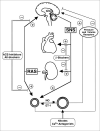Nitric oxide in hypertension
- PMID: 17170603
- PMCID: PMC8109558
- DOI: 10.1111/j.1524-6175.2006.06032.x
Nitric oxide in hypertension
Abstract
Hypertension is a major risk factor for cardiovascular disease, and reduction of elevated blood pressure significantly reduces the risk of cardiovascular events. Endothelial dysfunction, which is characterized by impairment of nitric oxide (NO) bioavailability, is an important risk factor for both hypertension and cardiovascular disease and may represent a major link between the conditions. Evidence suggests that NO plays a major role in regulating blood pressure and that impaired NO bioactivity is an important component of hypertension. Mice with disruption of the gene for endothelial NO synthase have elevated blood pressure levels compared with control animals, suggesting a genetic component to the link between impaired NO bioactivity and hypertension. Clinical studies have shown that patients with hypertension have a blunted arterial vasodilatory response to infusion of endothelium-dependent vasodilators and that inhibition of NO raises blood pressure. Impaired NO bioactivity is also implicated in arterial stiffness, a major mechanism of systolic hypertension. Clarification of the mechanisms of impaired NO bioactivity in hypertension could have important implications for the treatment of hypertension.
Figures







References
-
- Kearney PM, Whelton M, Reynolds K, et al. Global burden of hypertension: analysis of worldwide data. Lancet. 2005;365:217–223. - PubMed
-
- Hajjar I, Kotchen TA. Trends in prevalence, awareness, treatment, and control of hypertension in the United States, 1988–2000. JAMA. 2003;290:199–206. - PubMed
-
- Kearney PM, Whelton M, Reynolds K, et al. Worldwide prevalence of hypertension: a systematic review. J Hypertens. 2004;22:11–19. - PubMed
-
- Wolf‐Maier K, Cooper RS, Kramer H, et al. Hypertension treatment and control in five European countries, Canada, and the United States. Hypertension. 2004;43:10–17. - PubMed
-
- Lewington S, Clarke R, Qizilbash N, Et Al, and the Prospective Studies Collaboration. Age‐specific relevance of usual blood pressure to vascular mortality: a meta‐analysis of individual data for one million adults in 61 prospective studies. Lancet. 2002;360:1903–1913. - PubMed
Publication types
MeSH terms
Substances
LinkOut - more resources
Full Text Sources
Other Literature Sources
Medical

